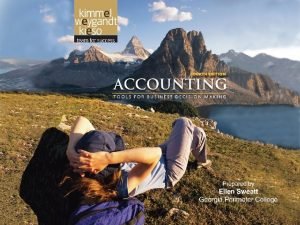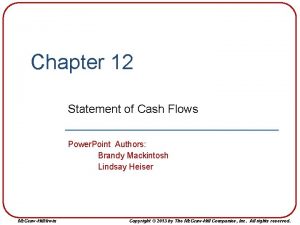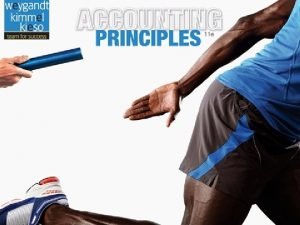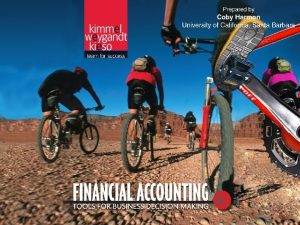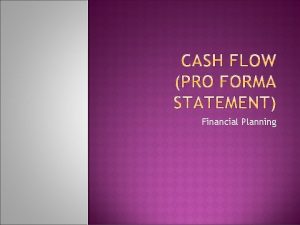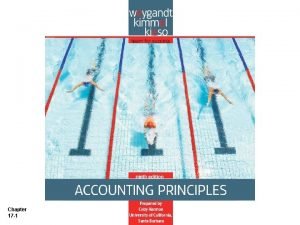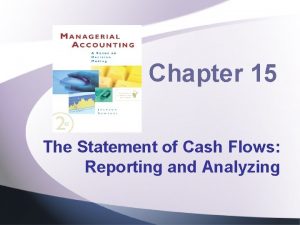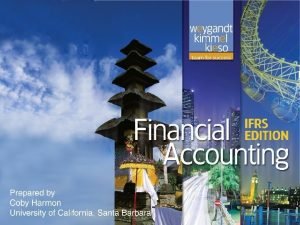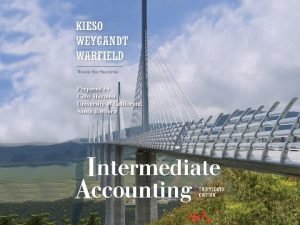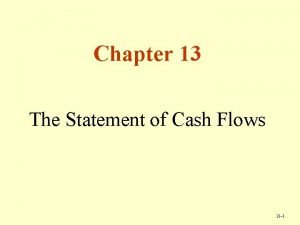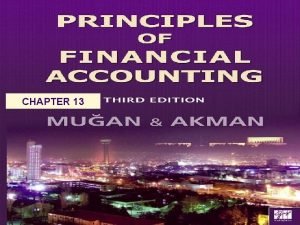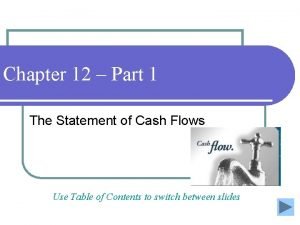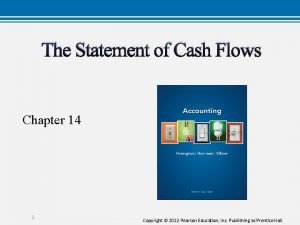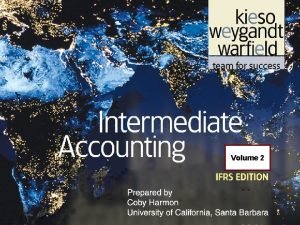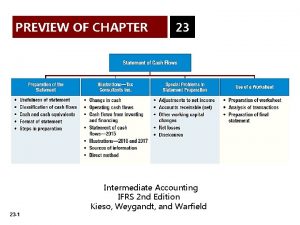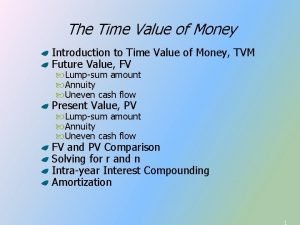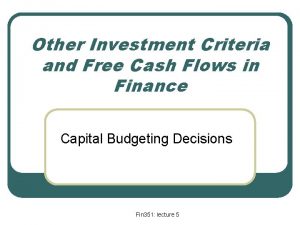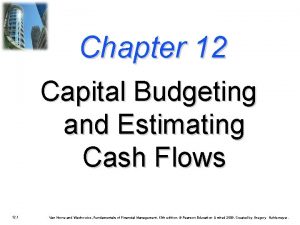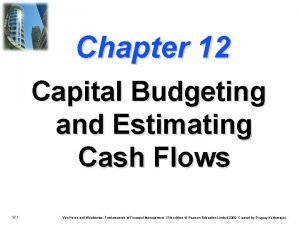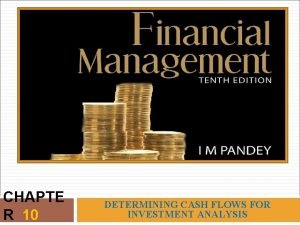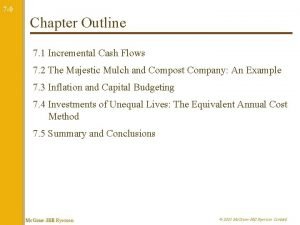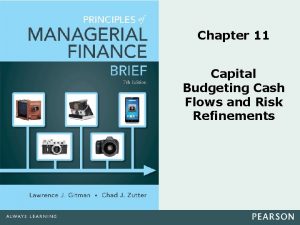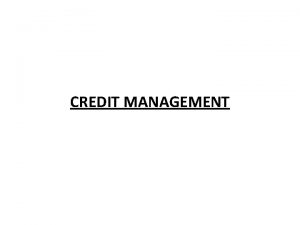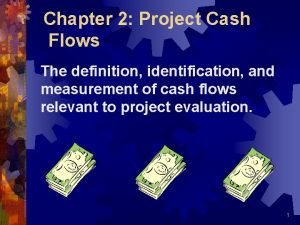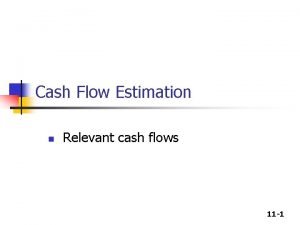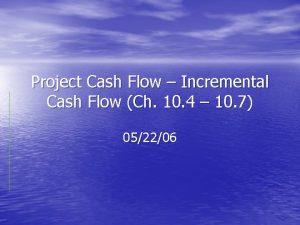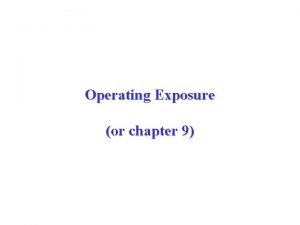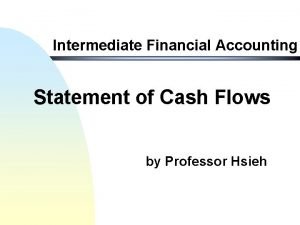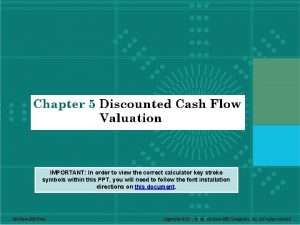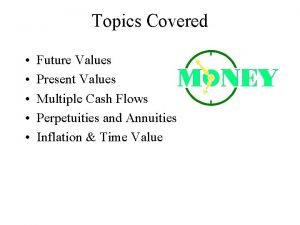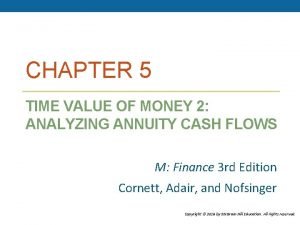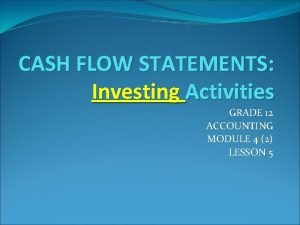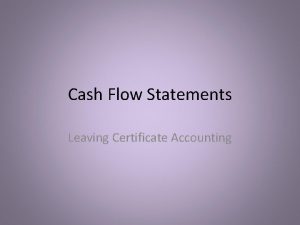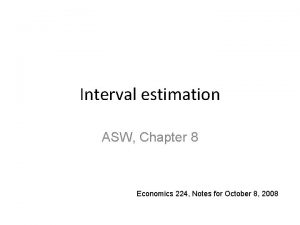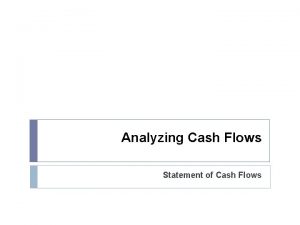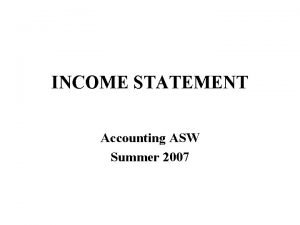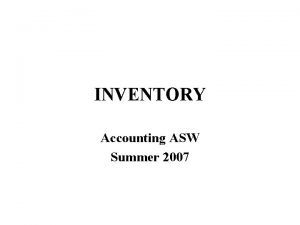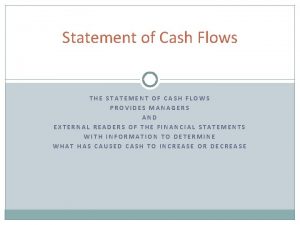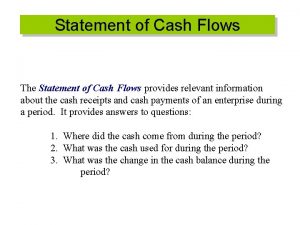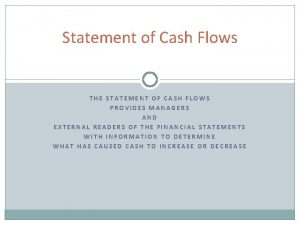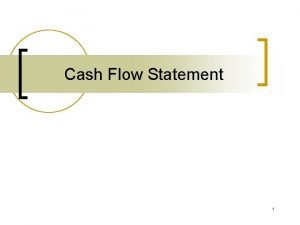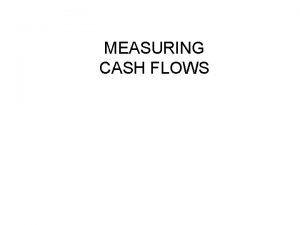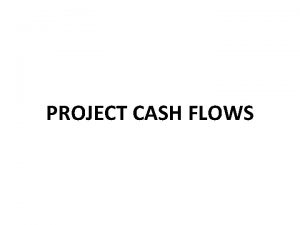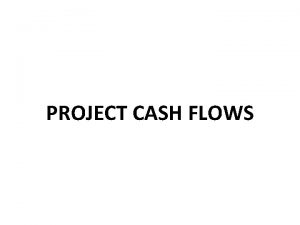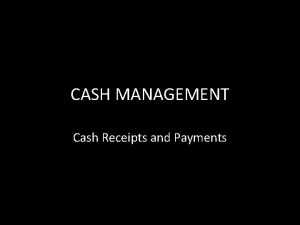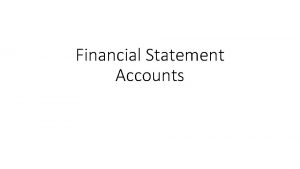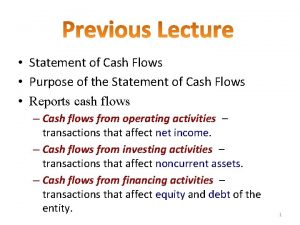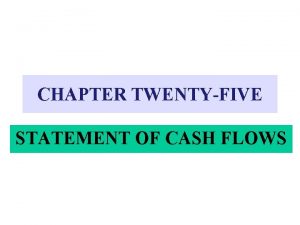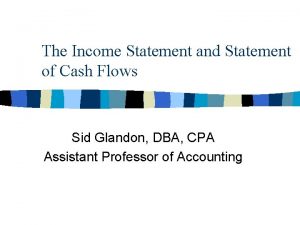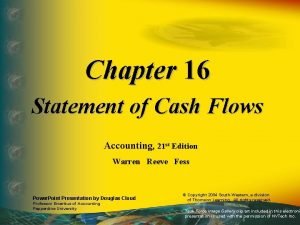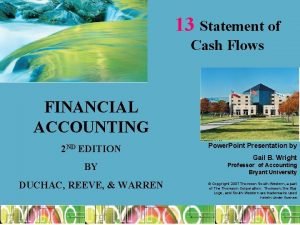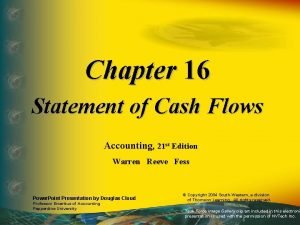STATEMENT OF CASH FLOWS Accounting ASW Summer 2007





































- Slides: 37

STATEMENT OF CASH FLOWS Accounting ASW Summer 2007

Overview of statement of cash flows • Explains changes in “Cash” during the period • “Cash” is cash plus cash equivalents - Equivalents are highly liquid short-term investments - E. g. , bank accounts, certificates of deposits, treasury bills and uncashed checks • There are typically no “SCF” accounts - infer SCF amounts from income statement and balance sheet - typically prepared after the other statements - hardest statement to interpret


Uses of SCF • Assess liquidity • Alternate measure of performance • Helpful in predicting free cash flows

Free Cash Flows • Free cash flows=Cash from Operations + Cash from Investing • Popular valuation approaches uses FCF - Firm value = net present value of future FCF • However, net income is the best predictor of future free cash flows

Relation between NI and FCF • In general, over the life of the firm Total(FCF) = Total(NI) • The only difference is timing • Most differences between NI and FCF reverse quickly - E. g. , credit sales CF < NI CF > NI now late r now later

Classification on the SCF • Specified by the FASB • Follows the structure of the firm - Operating - Investing - Financing



Components of the Statement of Cash Flows Operating Cash Inflows Cash Outflows Collect from customers Pay suppliers Collect interest and dividends Pay interest Other operating receipts Other operating payments Pay taxes Pay employees

Investing Cash Inflows Sell PP&E Cash Outflows Purchase PP&E Sell securities owned Purchase securities Receive loan repayments Make loans

Financing Cash Inflows Cash Outflows Borrow from creditors Repay amounts borrowed Issue equity securities Repurchase stock Pay dividends

Formats for SCF • Both direct and indirect are allowed • In both formats – investing and financing formats are the same • list sources and uses of cash – total operating cash flows is the same • format for getting there differs


• Direct method also lists sources and uses of cash for operating – preferred by FASB – rare in practice • Indirect method operating section starts with net income – explains why cash from operations NI – uses changes in other accounts to explain


• When CF NI, slack is picked up by changes in other balance sheet accounts – if sales > cash receipts, Accts. Receivable s – if sales < cash receipts, Accts. Receivable s – if purchases > cash paid, Accts. Payable s – if purchases < cash paid, Accts. Payable s – if purchases > cost of goods sold, Inventory s – if purchases < cost of goods sold, Inventory s

Preparing SCF (Indirect Method) • Start with attached worksheet with beginning and ending balances of non-cash accounts at ends & change in middle • As you work through, note each change that you’ve accounted for • If every change is accounted for, it must add

Preparing the Statement of Cash Flows Changes in Assets Operating Investing Financing (1) Accounts Receivable x(-) (2) Inventories x(-) (3) Other Current Assets (Usually) x(-) (4) Investments in Securities 1 Property, Plant & Equipment (5) Cost 2 (Purchases) (6) Acc. Depr. 2 (Current Yr’s Depr. ) (7) Other Noncurrent Assets (Usually)1 x(-) x(+) x(-)

Changes in Liabilities and Shareholders’ Equity Operating Investing Financing (8) Accounts Payable x(+) (9) Notes Payable 1 (10) Current Portion of Long. Term Debt 3 (11) Other Current Liabilities (Usually) x(+) (12) Long-Term Debt 1 (13) Deferred income Taxes x(+) (14) Other Noncurrent Liabilities (Usually)1 (15) Contributed Capital x(+) x(+)

Changes in Liabilities and Shareholders’ Equity Operating (16) Retained Earnings (17) Treasure Stock (18) Cash Investing x(Net Inc)(+) _____ Financing x (Div. )(-) x(-) Increases and decreases are generally disclosed separately. 2 For sales of PP&E (or other investments), profits are subtracted from net income in the operating section and the entire proceeds is included as a source of cash in the investing section. 3 Generally combined with long-term debt. 1 Problem 4 -26


Formats for the SCF Indirect Format (most common) Cash From Operations Net Income + Depreciation Gain on Sale of PP&E Increase in Accounts Receivable Increase in Inventory Increase in Other Current Assets + Increase in Accounts Payable + Increase in Other Current Liab. + Increase in Def. Income Taxes

Cash From Investing Investments in Securities + Proceeds from Sales of Sec. Investments in PP&E + Proceeds from Sales of PP&E Invest. in Other NC Assets + Proceeds from Other NC Assets

Cash From Financing + Issuance of Notes Payable Repayments of Notes Payable + Issuance of Long-Term Debt Repayments of Long-Term Debt + Issuance of Common Stock Dividends Paid Repurchase of Common Stock


Sales of PP&E • Recreate the journal entry Cash Selling Price Acc. Depr. AD on Asset PP&E HC on Asset Gain on Sale Plug • goal is for only selling price to appear in investing • to do that, subtract gain (add loss) in operating • show selling price as a source of investing cash • that takes care of the AD and PP&E on worksheet • Problem 4 -34, etc.








Direct Format (rare) • Financing and investing sections are the same as in the indirect method • The operating section is stated in terms of sources and uses of cash

Cash From Operations Cash Inflows + Collections from Customers + Interest and Dividends Received + Other Operating Receipts Cash Outflows Payments to Suppliers Payments to Employees Interest Paid Taxes Paid Other Operating Cash Payments

 The cash budget shows anticipated cash flows
The cash budget shows anticipated cash flows Statement of cash flows indirect method
Statement of cash flows indirect method Partial statement of cash flows
Partial statement of cash flows Partial statement of cash flows indirect method
Partial statement of cash flows indirect method Cash flow pro
Cash flow pro Prepaid expenses in cash flow statement
Prepaid expenses in cash flow statement The statement of cash flows reports
The statement of cash flows reports Chapter 13 statement of cash flows
Chapter 13 statement of cash flows Chapter 23 statement of cash flows
Chapter 23 statement of cash flows The statement of cash flows classifies items as
The statement of cash flows classifies items as Chapter 13 statement of cash flows
Chapter 13 statement of cash flows Flow chapter 13
Flow chapter 13 The statement of cash flows helps users
The statement of cash flows helps users Destiny corporation is preparing its
Destiny corporation is preparing its Chapter 23 statement of cash flows
Chapter 23 statement of cash flows Operating activities vs investing activities
Operating activities vs investing activities Intermediate accounting chapter 23
Intermediate accounting chapter 23 Asw accounting
Asw accounting Pv of cash flows formula
Pv of cash flows formula Incremental cash flows
Incremental cash flows Payback method formula
Payback method formula Incremental cash flows
Incremental cash flows Incremental cash flow
Incremental cash flow Working capital investment example
Working capital investment example Iatcf
Iatcf Change in net working capital
Change in net working capital Cash flow in credit management
Cash flow in credit management Relevant cash flows definition
Relevant cash flows definition Cash flow estimation
Cash flow estimation Incremental cash flows example
Incremental cash flows example Matching currency cash flows
Matching currency cash flows Intermediate cash flows
Intermediate cash flows Effective rate of interest
Effective rate of interest Future value of multiple cash flows example
Future value of multiple cash flows example Future value of multiple cash flows example
Future value of multiple cash flows example Example of investing activities
Example of investing activities Accounting leaving cert notes
Accounting leaving cert notes Asw 224
Asw 224
